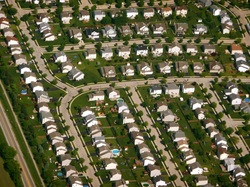
If you are in the market to buy a house, you may find yourself in developments touting some serious services—but not without a charge. Condominiums, townhouses, and other properties in certain planned developments can come with a homeowners association, or HOA. To live there, you must pay the HOA fees either monthly or annually. These can be great when it keeps your neighbors from painting their home neon green and when your swimming pool is always clean, but may seem less helpful when the rules feel too restrictive. If you are thinking about buying one of these types of properties, it’s a good idea to figure out how they work and what exactly these fees get you.
How it works
Gated neighborhoods or buildings with HOA fees often charge as much as $400 a month, with higher fees on a more upscale building with better amenities. These communities operate under the idea that many parties that live in the same area can help one another out with some shared needs. All residents are equally responsible for maintaining common areas, and there is usually a governing HOA board that works toward a better quality of life for residents, sets certain rules, and protects the property values for all properties. It’s important to learn the rules, and you may want to try to meet some other residents of the development you want to live in before making a final decision.
Maintenance
Every property requires maintenance, and, usually when you buy a home, all the responsibility falls on you. With an HOA, you don’t have to worry about all the costs and effort necessary for the upkeep of your property. There is usually a property manager who takes care of lawn care, trash removal, swimming pool and fitness room maintenance, snow removal, and common area upkeep (like elevators, lobbies, clubhouses, walkways, parking garages, etc.). Sometimes they even maintain your specific lawn.
Amenities
Perhaps one of the most attractive parts of living in an HOA community is the amenities that come with your home. Some offer pools, clubhouses, gyms, tennis courts, basketball courts, walking trails, gardens, and green space to name a few examples. The added entertainment benefit can outweigh the cost of the fees for residents.
Community
Many people who live in an HOA home or apartment appreciate the sense of community and security it affords them. You can meet neighbors and friends during HOA meetings if you choose to be active, or just through experiencing the shared spaces.
Insurance
There is usually a reserve fund for future improvements or unexpected damage repair, similar to a personal emergency fund. HOA fees also usually pay insurance for the building or common spaces, including hazard and liability coverage. Depending on what area your new home or apartment would be, it’s a good idea to research what insurance is included in the HOA fee.
While this is usually how homeowners associations work, every community has its own sets of rules and priorities. Before you hand over that first month’s rent or down payment on a home, consider what you can afford, if the benefits of HOAs are important to your household, and what exactly you would get out of a specific property.
From: http://www.realtor.com/advice/buy/what-hoa-fees-cover/
How it works
Gated neighborhoods or buildings with HOA fees often charge as much as $400 a month, with higher fees on a more upscale building with better amenities. These communities operate under the idea that many parties that live in the same area can help one another out with some shared needs. All residents are equally responsible for maintaining common areas, and there is usually a governing HOA board that works toward a better quality of life for residents, sets certain rules, and protects the property values for all properties. It’s important to learn the rules, and you may want to try to meet some other residents of the development you want to live in before making a final decision.
Maintenance
Every property requires maintenance, and, usually when you buy a home, all the responsibility falls on you. With an HOA, you don’t have to worry about all the costs and effort necessary for the upkeep of your property. There is usually a property manager who takes care of lawn care, trash removal, swimming pool and fitness room maintenance, snow removal, and common area upkeep (like elevators, lobbies, clubhouses, walkways, parking garages, etc.). Sometimes they even maintain your specific lawn.
Amenities
Perhaps one of the most attractive parts of living in an HOA community is the amenities that come with your home. Some offer pools, clubhouses, gyms, tennis courts, basketball courts, walking trails, gardens, and green space to name a few examples. The added entertainment benefit can outweigh the cost of the fees for residents.
Community
Many people who live in an HOA home or apartment appreciate the sense of community and security it affords them. You can meet neighbors and friends during HOA meetings if you choose to be active, or just through experiencing the shared spaces.
Insurance
There is usually a reserve fund for future improvements or unexpected damage repair, similar to a personal emergency fund. HOA fees also usually pay insurance for the building or common spaces, including hazard and liability coverage. Depending on what area your new home or apartment would be, it’s a good idea to research what insurance is included in the HOA fee.
While this is usually how homeowners associations work, every community has its own sets of rules and priorities. Before you hand over that first month’s rent or down payment on a home, consider what you can afford, if the benefits of HOAs are important to your household, and what exactly you would get out of a specific property.
From: http://www.realtor.com/advice/buy/what-hoa-fees-cover/
